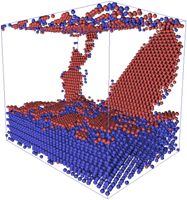Crossref Citations
This article has been cited by the following publications. This list is generated based on data provided by
Crossref.
Wang, J.
Kang, K.
Zhang, R. F.
Zheng, S. J.
Beyerlein, I. J.
and
Mara, N. A.
2012.
Structure and Property of Interfaces in ARB Cu/Nb Laminated Composites.
JOM,
Vol. 64,
Issue. 10,
p.
1208.
Zhang, Liang
and
Demkowicz, Michael J.
2013.
Morphological stability of Cu-Nb nanocomposites under high-energy collision cascades.
Applied Physics Letters,
Vol. 103,
Issue. 6,
Vo, Nhon Q.
Zhou, Jian
Ashkenazy, Yinon
Schwen, Daniel
Averback, Robert S.
and
Bellon, Pascal
2013.
Atomic Mixing in Metals Under Shear Deformation.
JOM,
Vol. 65,
Issue. 3,
p.
382.
Wang, Jian
Zhang, Ruifeng
Zhou, Caizhi
Beyerlein, Irene J.
and
Misra, Amit
2013.
Characterizing interface dislocations by atomically informed Frank-Bilby theory.
Journal of Materials Research,
Vol. 28,
Issue. 13,
p.
1646.
Salehinia, I.
Wang, J.
Bahr, D.F.
and
Zbib, H.M.
2014.
Molecular dynamics simulations of plastic deformation in Nb/NbC multilayers.
International Journal of Plasticity,
Vol. 59,
Issue. ,
p.
119.
Ekiz, E.H.
Lach, T.G.
Averback, R.S.
Mara, N.A.
Beyerlein, I.J.
Pouryazdan, M.
Hahn, H.
and
Bellon, P.
2014.
Microstructural evolution of nanolayered Cu–Nb composites subjected to high-pressure torsion.
Acta Materialia,
Vol. 72,
Issue. ,
p.
178.
Darling, K.A.
Roberts, A.J.
Armstrong, L.
Kapoor, D.
Tschopp, M.A.
Kecskes, L.J.
and
Mathaudhu, S.N.
2014.
Influence of Mn solute content on grain size reduction and improved strength in mechanically alloyed Al–Mn alloys.
Materials Science and Engineering: A,
Vol. 589,
Issue. ,
p.
57.
Mao, Shimin
Özerinç, Sezer
King, William P.
Averback, Robert S.
and
Dillon, Shen J.
2014.
Effect of irradiation damage on the shear strength of Cu–Nb interfaces.
Scripta Materialia,
Vol. 90-91,
Issue. ,
p.
29.
Zhou, J.
Averback, R.S.
and
Bellon, P.
2014.
Stability and amorphization of Cu–Nb interfaces during severe plastic deformation: Molecular dynamics simulations of simple shear.
Acta Materialia,
Vol. 73,
Issue. ,
p.
116.
Wang, J.
Zhang, R.F.
Zhou, C.Z.
Beyerlein, I.J.
and
Misra, A.
2014.
Interface dislocation patterns and dislocation nucleation in face-centered-cubic and body-centered-cubic bicrystal interfaces.
International Journal of Plasticity,
Vol. 53,
Issue. ,
p.
40.
Cordero, Zachary C.
and
Schuh, Christopher A.
2015.
Phase strength effects on chemical mixing in extensively deformed alloys.
Acta Materialia,
Vol. 82,
Issue. ,
p.
123.
Komarasamy, Mageshwari
Mishra, Rajiv S.
Mukherjee, Sundeep
and
Young, Marcus L.
2015.
Friction Stir-Processed Thermally Stable Immiscible Nanostructured Alloys.
JOM,
Vol. 67,
Issue. 12,
p.
2820.
Abad, M.D.
Parker, S.
Kiener, D.
Primorac, M.-M.
and
Hosemann, P.
2015.
Microstructure and mechanical properties of CuxNb1−x alloys prepared by ball milling and high pressure torsion compacting.
Journal of Alloys and Compounds,
Vol. 630,
Issue. ,
p.
117.
Beyerlein, I.J.
Demkowicz, M.J.
Misra, A.
and
Uberuaga, B.P.
2015.
Defect-interface interactions.
Progress in Materials Science,
Vol. 74,
Issue. ,
p.
125.
Shao, Shuai
Wang, Jian
Beyerlein, Irene J.
and
Misra, Amit
2015.
Glide dislocation nucleation from dislocation nodes at semi-coherent {1 1 1} Cu–Ni interfaces.
Acta Materialia,
Vol. 98,
Issue. ,
p.
206.
Bachmaier, A.
Schmauch, J.
Aboulfadl, H.
Verch, A.
and
Motz, C.
2016.
On the process of co-deformation and phase dissolution in a hard-soft immiscible Cu Co alloy system during high-pressure torsion deformation.
Acta Materialia,
Vol. 115,
Issue. ,
p.
333.
Palanivel, S.
Arora, A.
Doherty, K.J.
and
Mishra, R.S.
2016.
A framework for shear driven dissolution of thermally stable particles during friction stir welding and processing.
Materials Science and Engineering: A,
Vol. 678,
Issue. ,
p.
308.
Chen, Y.
Li, N.
Hoagland, R.G.
Liu, X.-Y.
Baldwin, J.K.
Beyerlein, I.J.
Cheng, J.Y.
and
Mara, N.A.
2020.
Effects of three-dimensional Cu/Nb interfaces on strengthening and shear banding in nanoscale metallic multilayers.
Acta Materialia,
Vol. 199,
Issue. ,
p.
593.
Kaspar, Tiffany C.
Pang, Qin
Sushko, Peter V.
Bowden, Mark E.
Tao, Jinhui
Gwalani, Bharat
Olszta, Matt
Efe, Mert
Devaraj, Arun
and
Rohatgi, Aashish
2021.
Metastable orientation relationships in thin film Cu-Cr bilayers.
Scripta Materialia,
Vol. 194,
Issue. ,
p.
113635.
Overman, N.R.
Li, X.
Olszta, M.J.
Nickerson, E.K.
Overman, C.T.
Mathaudhu, S.N.
Grant, G.J.
and
Whalen, S.A.
2021.
Microstructural progression of shear-induced mixing in a CuNi alloy.
Materials Characterization,
Vol. 171,
Issue. ,
p.
110759.





